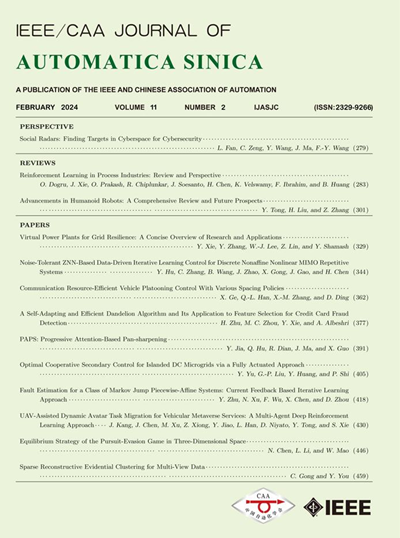城市空域有限视野下多无人机协同追击策略:多智能体强化学习方法
IF 19.2
1区 计算机科学
Q1 AUTOMATION & CONTROL SYSTEMS
引用次数: 0
摘要
应用多架无人机对非法无人机进行追踪和捕获已成为保障城市空域安全的一种新途径。然而,追踪无人机需要利用自己的传感器来主动收集未经授权的无人机的信息。针对传感器感知范围有限的问题,提出了一种具有有限视野的多无人机追逃问题。每个追踪者的视野范围都是有限的感知距离和视角,可能会受到建筑物的阻碍。只有当未经授权的无人机,即逃避者进入任何追踪者的视野时,才能获得其位置。追赶者的目标是在不发生碰撞的情况下,尽快捕获逃避者。为了解决这个问题,我们提出了一种多智能体强化学习(MARL)方法,即规范化流参与者与图注意批评家(NAGC)算法。NAGC执行规范化流来增强策略网络的灵活性,使代理能够从更复杂的分布(而不是普通分布)中采样操作。为了增强同时理解多架无人机和环境障碍物之间空间关系的能力,NAGC集成了“障碍物-目标”图注意网络,显著帮助追踪者支持搜索或追击活动。在高精度模拟器上进行的大量实验验证了NAGC算法的良好性能。本文章由计算机程序翻译,如有差异,请以英文原文为准。
Multi-UAV Cooperative Pursuit Strategy with Limited Visual Field in Urban Airspace: A Multi-Agent Reinforcement Learning Approach
The application of multiple unmanned aerial vehicles (UAVs) for the pursuit and capture of unauthorized UAVs has emerged as a novel approach to ensuring the safety of urban airspace. However, pursuit UAVs necessitate the utilization of their own sensors to proactively gather information from the unauthorized UAV. Considering the restricted sensing range of sensors, this paper proposes a multi-UAV with limited visual field pursuit-evasion (MUV-PE) problem. Each pursuer has a visual field characterized by limited perception distance and viewing angle, potentially obstructed by buildings. Only when the unauthorized UAV, i.e., the evader, enters the visual field of any pursuer can its position be acquired. The objective of the pursuers is to capture the evader as soon as possible without collision. To address this problem, we propose the normalizing flow actor with graph attention critic (NAGC) algorithm, a multi-agent reinforcement learning (MARL) approach. NAGC executes normalizing flows to augment the flexibility of policy network, enabling the agent to sample actions from more intricate distributions rather than common distributions. To enhance the capability of simultaneously comprehending spatial relationships among multiple UAVs and environmental obstacles, NAGC integrates the “obstacle-target” graph attention networks, significantly aiding pursuers in supporting search or pursuit activities. Extensive experiments conducted in a high-precision simulator validate the promising performance of the NAGC algorithm.
求助全文
通过发布文献求助,成功后即可免费获取论文全文。
去求助
来源期刊

Ieee-Caa Journal of Automatica Sinica
Engineering-Control and Systems Engineering
CiteScore
23.50
自引率
11.00%
发文量
880
期刊介绍:
The IEEE/CAA Journal of Automatica Sinica is a reputable journal that publishes high-quality papers in English on original theoretical/experimental research and development in the field of automation. The journal covers a wide range of topics including automatic control, artificial intelligence and intelligent control, systems theory and engineering, pattern recognition and intelligent systems, automation engineering and applications, information processing and information systems, network-based automation, robotics, sensing and measurement, and navigation, guidance, and control.
Additionally, the journal is abstracted/indexed in several prominent databases including SCIE (Science Citation Index Expanded), EI (Engineering Index), Inspec, Scopus, SCImago, DBLP, CNKI (China National Knowledge Infrastructure), CSCD (Chinese Science Citation Database), and IEEE Xplore.
 求助内容:
求助内容: 应助结果提醒方式:
应助结果提醒方式:


